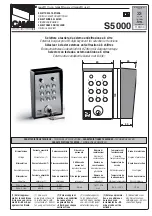
KDFX Reference
KDFX Algorithm Specifications
10-47
139 Switch Loops
Looped delay lines with input switching
PAUs:
2
Switch Loops
allows you to run up to four parallel recirculating delay lines of different lengths, switching
which delay line(s) are receiving the input signal at a given moment. The stereo input is summed to mono
and sent to any of the four delay lines. You can select which delay lines are receiving input with the
DlySelect parameters.
The gain in decibels of each of the four delays can be set individually. The amount of feedback to apply to
each delay is set with a DecayRate parameter. The DecayRate controls how many decibels the signal will
be reduced for every second the signal is recirculating in the delay.
The length of the delays are set based on tempo (system tempo or set locally) and duration in beats.
Assuming a 4/4 time signature with tempo beats on the quarter note, 8/24 bts is an eighth triplet (8/24
equals 1/3 of a quarter note), 12/24 bts is an eighth, 16/24 bts is a quarter triplet, and 1 bts is a quarter note
duration. Dividing the quarter note into 24ths, allows delay lengths based on the most common note
lengths. To determine a delay length in seconds, divide the length of the delay (in beats) by the tempo and
multiply by 60 seconds/minute (beats/tempo
❃
60).
Switch Loops
has a few more specialized parameters. HF Damping controls a one pole lowpass
fi
lter on
each of the delay lines. Max Fdbk overrides all of the DecayRate parameters and prevents the signals in the
delay lines from decaying at all. Fdbk Kill will override the DecayRate parameters and the Max Fdbk
parameter by completely turning of the feedback for all the delays. Fdbk Kill stops all the delay line
recirculation.
The outputs of all the delay lines are summed, and the output gain is applied to the mono result which can
be panned between the two output channels.
Figure 12
Switch Loops
L Input
R Input
HF Damping
Delay A
Decay Rate A
Gain A
Delay
Select
Fdbk Kill = 0
Max Fdbk = 1
(
)
HF Damping
Delay B
Decay Rate B
Gain B
Delay
Select
HF Damping
Delay C
Decay Rate C
Gain C
Delay
Select
HF Damping
Delay D
Decay Rate D
Gain D
Delay
Select
Out Gain
Pan
Dry In/Out
Dry Gain
Dry In/Out
Dry Gain
L Output
R Output
Summary of Contents for K2661
Page 18: ...2 4 LFOs LFO Shapes...
Page 34: ...3 16 DSP Algorithms...
Page 54: ...5 4 MIDI Note Numbers Note Numbers for Percussion Keymaps...
Page 72: ...7 10 System Exclusive Protocol K2661 System Exclusive Implementation...
Page 82: ...9 4 Upgrading Sample Memory Choosing and Installing a SIMM for K2661 Sample Memory...
Page 334: ...10 252 KDFX Reference KDFX Algorithm Specifications...
Page 340: ...11 6 Glossary...
Page 382: ...12 42 Triple Modular Processing Alphanumeric Buttonpad Entries for DSP Functions...
Page 392: ...B 6 SysEx Control of KDFX MSB and LSB...
Page 442: ...D 20 Contemporary ROM Block Objects Controller Assignments Contemporary ROM Block...
Page 490: ...H 12 General MIDI Standard Mode Controller Assignments...
Page 492: ...I 2 Live Mode Objects Live Mode Programs...
Page 498: ...K2661 Musician s Reference Index...
Page 500: ......
















































